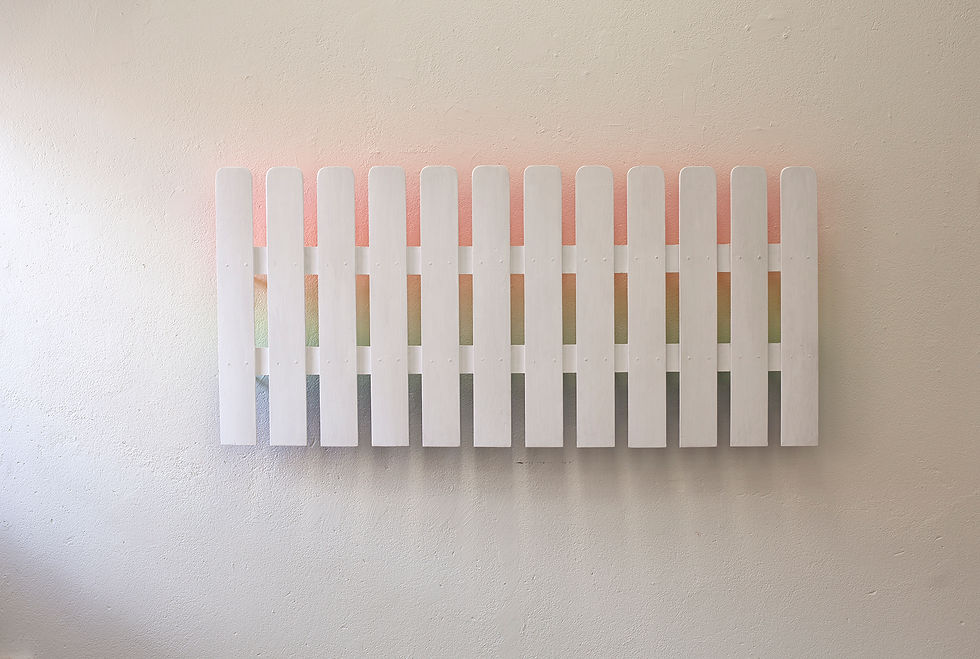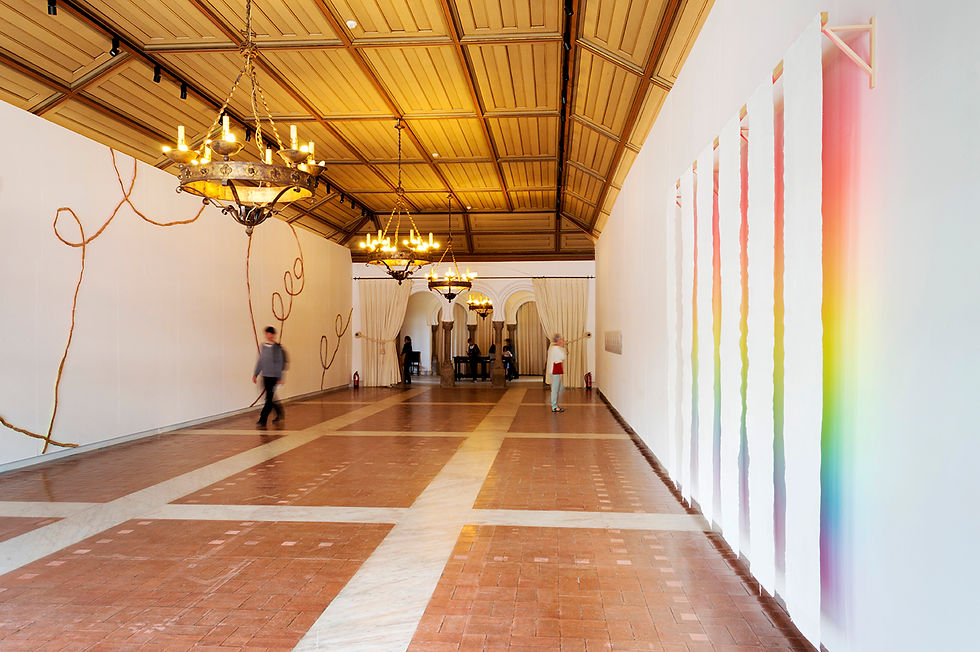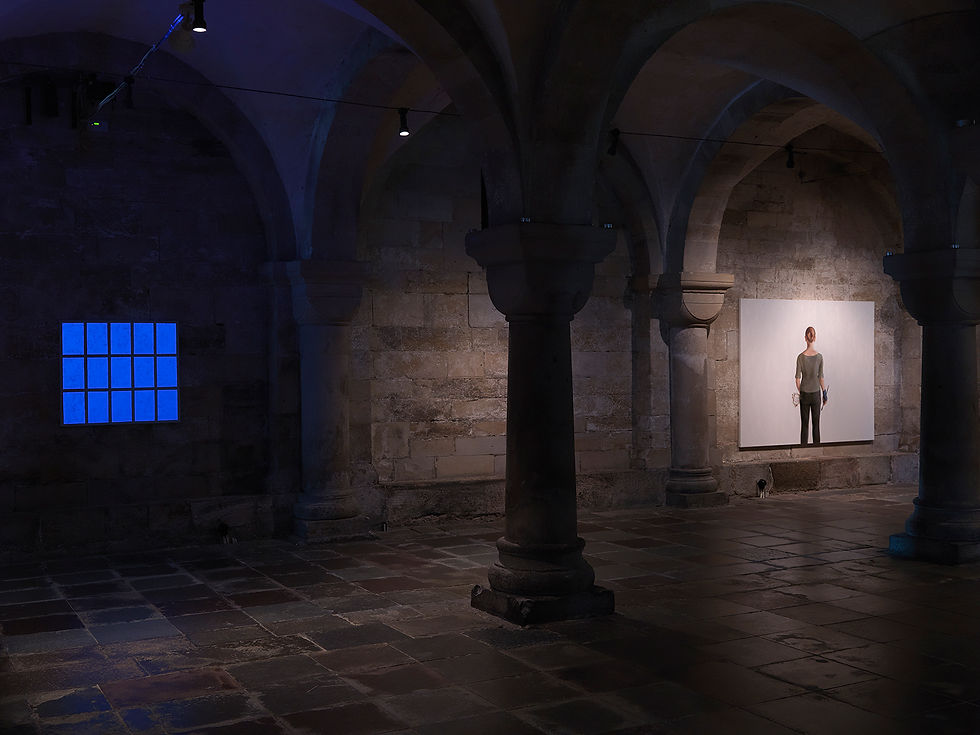



En särskild sol/A Sun of One's Own
Aguélimuseet, Sala 2015
An exhibition in dialogue with the Swedish painter and mystic Ivan Aguéli (1869-1917), also known by his sufi-name Sheikh 'Abd al-Hādī 'Aqīlī.




QUALIA - language but no words/linguagem mas sem palavras
An installation for Palácio de Dom Manuel, Évora, Portugal 2014. Organized by Foundation Obras and Câmara Municipal de Évora, supported by the Swedish Embassy in Lisbon.
Photo: Manuel Ribeiro




TRANSIT
Installation Lund Cathedral 2012
The title of the installation – Transit – can refer to passage, where one emphasizes art as a place for change and going beyond. In it´s composition the exhibition transcended borders in terms of material and technology where oil paintings was integrated with Black light.
The crypt itself is a place of transition. Throughout history, many people have walked through the crypt. The decorated well gives us reason to believe that christenings were performed here. The grave slabs remind us of death as a boundary and as a gateway to another existence. If the cathedral is the body, then the crypt is its heart, its inner room. It is darker here and it takes a while for ones eyes to adjust, when coming down from the lighter aisles of the church above. We are invited to stop a while and wait for the interplay of eye, light and stone. Wandering between the columns has a rhythm all of its own.
Dahlén experiments with colours as the carrier of light and they seem to hover in the air with lightness meeting the weight of the stone. The artist paints with light just as the architects interplay with light in order to build the room. (...)
Erika Dahlén is interested in an artwork's origin. She examines how the work emerges and comes into being. The work continues to be created in an interaction with the observer, space and light.
Lena Sjöstrand, Cathedral Chaplain
" [...] The wiping cloth in the painter's hand is of the sort which must eventually get stained, haphazardly. The cloth takes part in the process, an initiated recipient of actions and decisions, impulses and considerations, perhaps even momentary breakdowns. The white fabric receives without resistance. It makes no demands on its own handling, has no opinions or demands of aesthetic order and execution. Whatever happens happens as it does when a form occurs on its own without supervision. Meanwhile the artist is busy depicting her own form against a light or dark background.
But when the cloth unfolds an image free from aim and purpose appears through its creases ("Trasa II/Cloth II"). It was not upon this humble piece of cloth that the intended – the painting, the work of art – was meant to appear. And yet it happened. In the moment where the painter becomes aware of how the assistant, the cloth, bears witness to a new act that encompasses them both, and subsequently lets the image of the cloth manifest itself on a canvas, a new metaphor with its own potential meaning emerges.
The origination of paint on material, a quiet visual miracle bearing equal radiance to the magical painting ("Painting I"), whose pulsating sky blue surface captures the gaze of the spectator and reminds us that colour is a wonder of light that breaks sevenfold in movement and direction."
Nina Weibull, Ph.D., Senior Curator, The Art Collections, Stockholm University, Editor of Divan - Journal of Psychoanalysis and Culture
Translation: Katja Larsson
Photo: Anna Kallberg




IN MEMORIAM
Katarina kyrka, Stockholm 2010
The installation IN MEMORIAM, that opened during All Soul´s Day, was about death but also about people who have come to be role models. Not due to any recognised spectacular deed, but because they have - in the midst of their human imperfection - been able to bring joy, hope and inspiration to somebody in their surroundings. People that have left a strong impression on someone's life, helped somebody keep their spirits up and made life a little easier to live.
By handing in photographs of a passed away loved one, who in his or her life acted as a role model in this capacity, anybody who wanted to could contribute to the work. The images were scanned, digitally processed and printed on transparent film in order to be attached to the windows of the church.
Participants could also contribute with a text or simply write the name of their chosen person and put up on the wall. The exhibition kept expanding with visitors adding new texts and images and grew into a rich material consisting of accounts of many compelling destinies of the people depicted. Those handing in images were largely individuals, but work places and schools also contributed in different ways. Seventh graders from a nearby school made linoleum prints and wrote texts about the loved ones they had lost.
The installation IN MEMORIAM served to remind us about the impressions we make in each others lives and that every human has a story worth telling.
Photo: Jann Lipka
Panorama view of the installation: http://www.360cities.net/image/in-memoriam-erika-dahlen-katarina-kyrka#34.90,-23.20,70.0 (photo: Jann Lipka)